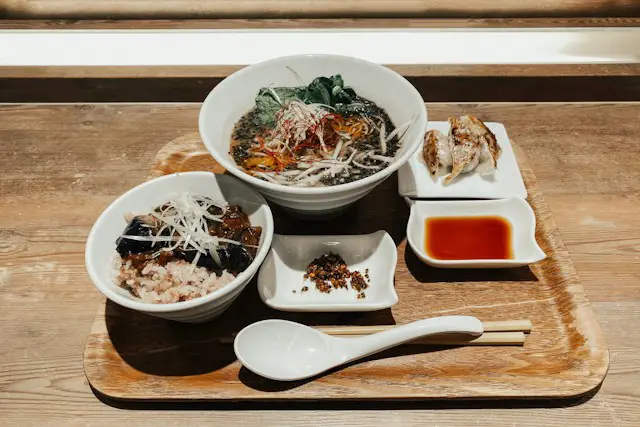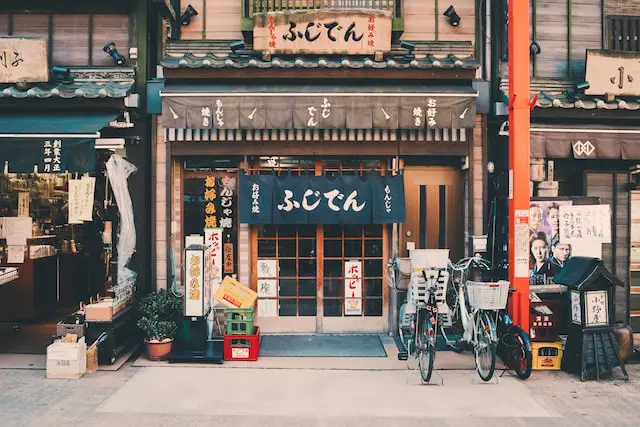Welcome to our deep dive into vegetarian and vegan eating in the wonderful land of Japan! In this comprehensive guide, we will be exploring the availability and variety of vegetarian and vegan options that this traditionally fish and meat-loving country has to offer.
From Kyoto’s elegant vegetarian restaurants to delectable vegan options in the bustling city of Tokyo, your quest for veggie-friendly fare in Japan is about to get a lot easier. Embark on a taste adventure with us as we uncover authentic Japanese vegetarian dishes and Japanese vegan food that will tantalize your taste buds.
Read on to get a taste of what awaits you. Don’t forget to bookmark this page, and use our search terms like ‘vegetarian restaurants in Japan’, ‘vegan options in Tokyo’, ‘Japanese vegan food’, and ‘Japanese vegetarian dishes’ for quick navigation. Itadakimasu!
Understanding Japanese Dietary Culture
Japan has a rich culinary tradition that is often regarded as one of the world’s most diverse and refined. Its dietary culture is deeply rooted in the country’s geography, artistry, and traditional philosophy, making it a distinct culinary experience.
The core principles of Japanese cuisine are centered around seasonality, local produce, and a balanced diet. Particularly, the concept of “washoku” – the traditional Japanese diet, emphasizes a balance of taste, techniques, appearance, and colors on the plate.
Despite the ubiquity of fish and seafood in Japanese food culture, vegetarianism and veganism are not new concepts to Japan. The tradition of ‘Buddhist vegetarianism’, known as “shōjin ryōri”, has played a prevalent role for many centuries. These are meals prepared without meat, fish or other animal products, showcasing the Buddhist principle of non-harming.
Sadly, these plant-based dining concepts are more common in religious settings and historical contexts than in present-day casual dining. Contemporary Japan, particularly urban centers, is heavily meat and seafood-centric. Yet, a gradual shift towards plant-based Japan is underway.
Indeed, this does not imply that Japan does not offer vegetarian and vegan options. An array of vegetarian-friendly dishes exist, often disguised as generally popular dishes. The key is to understand what to look for and how to navigate the diverse culinary landscape of Japan as a vegetarian or vegan.
Whether you’re fully committed to a plant-based diet or just curious about incorporating more vegetarian or vegan meals into your travel diet, Japan offers an immersive culinary journey waiting to be savored. This guide will equip you with all the must-know information for your foray into vegetarian and vegan eating in Japan.
Knowing the Basics: Key Japanese Terms for Vegetarians and Vegans
If you’re a vegetarian or vegan traveling in Japan, learning some specific Japanese phrases can significantly enhance the foodie expedition. While the sheer diversity of Japanese cuisine can be dizzying, familiarising yourself with a few key terms will ensure that you navigate this visually enchanting culinary landscape with confidence and ease.
The word for vegetarian in Japanese is ‘saishoku shugi sha’, but this term isn’t well-known in many restaurants. So, as a vegetarian or vegan traveler, using the term ‘yasai shoku’ (vegetable food) could be more useful. The word ‘vegan’ in Japanese is ‘bigan’, but it might not be universally understood, so it’s advisable to specify individual dietary restrictions.
Every vegetarian/vegan should know the characters ‘肉’ (niku, meaning meat) and ‘魚’ (sakana, meaning fish) as they are regularly present in menus. Look out for soups and broths, as they often contain ‘だし’ (dashi) – a fish stock that forms the basis of many Japanese recipes.
To specify that you do not eat animal products, you can say: ‘Watashi wa niku to sakana wo taberimasen’ (I do not eat meat and fish). For vegans, the phrase ‘Watashi wa dobutsu kei no shokuhin wa tabemasen’ (I do not eat animal-derived products) will come in handy.
Navigating dietary choices in a foreign language might seem daunting initially, but with this arsenal of phrases, you’re equipped to embrace ‘Japanese vegan vocab’ and effortlessly ‘translate food ingredients in Japan’. Bon voyage and itadakimasu!
Staple Ingredients in Japanese Cuisine: Traps for the Unwary Vegetarian/Vegan
If you’re new to the world of Japanese cuisine, especially as a vegetarian or vegan, there are a few ingredients you need to be aware of. Often, you might find dishes that appear vegan or vegetarian but contain hidden animal products. It’s essential to know these ‘traps’ to help you navigate through your food adventure in Japan.
First among these is Dashi, a staple in Japanese cooking often used to season dishes. Typically made from dried fish (Katsuobushi) or fermented soybeans and sea kelp (Shiitake-Kombu), it’s frequently used in soups, sauces, and even rice dishes, making them unsuitable for a strict vegetarian or vegan diet. Sharing similar concern is the widely loved Miso Soup, which is commonly Dashi-based.
Another ingredient to watch out for is Worcestershire sauce, often included in Okonomiyaki and Yakisoba sauces. It contains anchovies and isn’t suitable for vegetarians or vegans. Also, while Japanese green tea seems safe, some varieties are made using a small amount of fish scale to add sparkle, something usually not advertised on packaging.
Japanese sweets, too, can be tricky. Traditional Wagashi (Japanese sweets) like ‘Yokan’ and ‘Anko’ (red bean paste) are generally vegan-friendly, but many modern Japanese sweets can contain gelatine, dairy products, or eggs.
In conclusion, it’s advisable to do a little research before ordering or dig a bit deeper when shopping at local markets in Japan. And don’t hesitate to ask questions – a phrasebook or translation app can be a great asset for this.
Top Vegetarian-Friendly Japanese Dishes
If your palate longs for culinary exploration in Japan whilst maintaining a vegetarian or vegan lifestyle, rest assured, there’s no shortage of delectable options to satisfy your taste buds. Not everything is meat or fish based in Japanese cuisine. Here are some outstanding dishes that are naturally vegetarian or can be easily modified to be.
1. Vegan Sushi: Sushi, the iconic Japanese dish, is not just about fish. Many sushi restaurants offer veggie-friendly options, filled with cucumber, avocado, pickled radish, and fermented soybeans (natto). Ask for sushi without wasabi if you’re unsure about its vegan status.
2. Vegetarian Ramen: Ramen is a traditional Japanese noodle soup. It typically contains pork broth but many ramen shops now provide vegetarian broth options, usually soy or miso-based, which you can pair with an array of vegetable toppings.
3. Yasai Tempura: A classic Japanese dish, tempura vegetables are battered and deep-fried, making for a delicious and satiating meal.
4. Miso Soup: Standard in almost every Japanese meal, miso soup can be vegan if made with kelp or vegetable stock instead of traditional dashi, which contains fish flakes.
5. Onigiri: Simple yet satisfying, these rice balls wrapped in seaweed often come with vegetable fillings like pickled plums or seaweed, making them an excellent on-the-go snack.
A journey through Japan’s vegan sushi, vegetarian ramen, and other plant-based dishes promises to be as exciting and diverse as the country itself. Stay tuned for our guide on navigating Japan’s vegan and vegetarian restaurants, and immerse yourself in a true Japanese vegan food experience!
Navigating Japan: A Guide to Finding Vegan and Vegetarian Restaurants
As a vegan or vegetarian traveler in Japan, finding places to eat that cater to your dietary needs can be a thrill of its own. The nation’s cuisines are increasingly embracing plant-based ingredients, making it easier than ever to find delicious vegetarian and vegan dishes.
Tokyo, the bustling capital city, teems with vegan-friendly dining spots. Utilize keywords such as “vegan restaurants in Tokyo” to locate restaurants offering robust vegan menus in districts such as Shibuya and Asakusa. For instance, T’s Tantan in Tokyo station offers a variety of vegan ramen options.
The historic city of Kyoto also possesses its unique vegetarian food scene. Seek out the “shojin ryori” or Buddhist vegetarian cuisine temples for an authentic and flavorful meal. “Kyoto vegetarian restaurants” is a helpful search term for discovering spots like Biotei, known for organic, locally-sourced vegetarian meals.
Apps like HappyCow Japan are a handy resource for locating vegan and vegetarian restaurants across the country. It’s a community-driven app that filters restaurant options based on dietary needs. HappyCow can help you uncover hidden gems even in less-explored places.
Japan is remarkably accommodating to various diets, despite its reputation for seafood-centric dishes. The key is to remain open to new experiences, to savor the beauty of the moment — a hallmark of Japanese culture that extends to its diverse food scene. So prepare your palate for an exciting journey in the land of the rising sun!
Tips for Ordering Vegan & Vegetarian Food in Japan
Navigating the Japanese culinary landscape as a vegan or vegetarian may initially seem challenging but don’t worry, we’re here to ensure the task feels less daunting.
Most crucially, arm yourself with essential phrases. ‘Watashi wa vejetarian desu’ translates to ‘I am a vegetarian’. If you’re a vegan, say ‘Watashi wa bīgan desu’. Clearly mention ‘niku wo taberemasen’ to clarify that you don’t eat meat and ‘sakana mo tabemasen’ if you also exclude fish.
While ordering, opt for dishes you know are typically vegan or vegetarian like edamame, miso soup, and vegetable sushi. Be cautious of seemingly vegetarian dishes, as broths often contain fish or meat stock. Your phrasebook should include ‘katsuo dashi nashi de onegaishimasu’ which requests no bonito fish flakes in your food.
When in doubt, choose a Shojin Ryori meal. This is traditional Buddhist cuisine in Japan and is naturally vegan. It’s a unique, delicate, and nutritious food style that’s deeply connected with Japanese culture.
Don’t forget to make use of technology. Applications like HappyCow can become your guide to vegan and vegetarian restaurants in any Japanese city. This tool is incredibly useful in finding restaurants that cater specifically to your dietary needs.
Being a vegan or vegetarian in Japan should not limit the depth of your culinary experience. By preparing ahead, keeping your phrasebook handy, and making wise choices, your Japanese food adventure can be as enriching and delightful as any other.
Remember, ‘tabemono no tabi’, or food journey, is an essential part of truly experiencing Japan, its culture and the warmth of its people. So, don’t hold back. Dive in!
Conclusion
Having traversed the journey of understanding vegetarian and vegan food culture in Japan, it’s time now for the real adventure to begin. Remember, Japan isn’t just about sushi, ramen, and tempura – there’s an abundance of vegetarian and vegan dishes waiting to tempt your taste buds.
The challenge of finding vegetarian or vegan cuisine in a country renowned for its seafood can seem daunting. However, armed with a hearty appetite, some key Japanese phrases, and most importantly, an adventurous spirit, you’ll discover unique flavors, innovative techniques, and traditional dishes that respect and showcase the bountiful plant-based delights the country has to offer.
The terms like ‘vegan sushi’, ‘vegetarian ramen’, ‘miso soup vegan’, and countless others will not only revolutionize your understanding of Japanese cuisine but also magnify your appreciation for how a country’s culture can deeply influence its food. So embrace the ‘Japan food adventure’ and immerse yourself in this ‘vegetarian travel in Japan’.
In the world of Japanese cuisine, there are more layers to uncover and more dishes to sample than one could ever imagine. Let this ‘vegan journey in Japan’ be a thrilling exploration of taste, textures, traditions, and a testament to the universality of good food. No matter what dietary choices you make, there’s a spot at the table for you in Japan. Itadakimasu – let’s eat!




